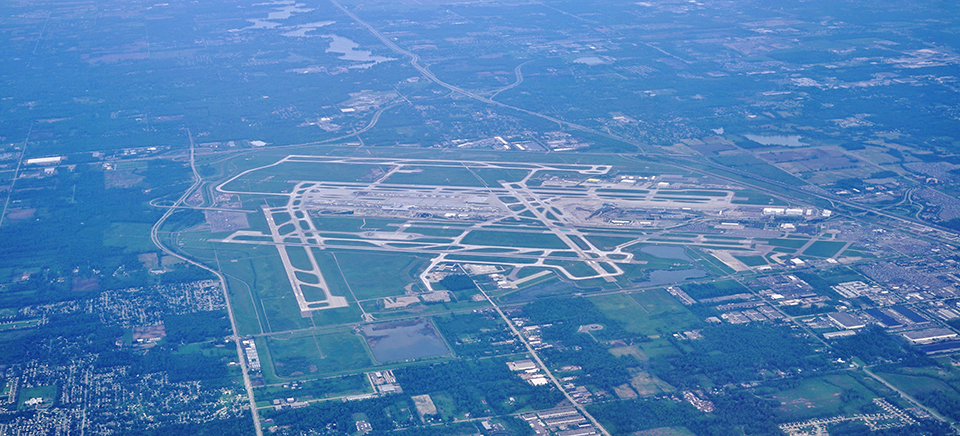Apr 03, 2018

Many metro Detroiters view the airport as a way to get from one place to another, but it is also a major economic development influence in our community. There are two airports in the Detroit Aerotropolis Region: Detroit Metropolitan Airport in Romulus and Willow Run Airport in Ypsilanti. Both airports are operated by the Wayne County Airport Authority (WCAA).
The WCAA is continually seeking to improve the efficiency of its operations and enhance the overall experience for passengers. “Our goal is to provide a world-class passenger experience,” explains Wendy Sutton, Vice President of Business Development and Real Estate for the Wayne County Airport Authority. “We also want to make sure the region is competitive for economic development.”
Flying non-stop to nearly 140 destinations, including 28 international destinations, Detroit Metro Airport is the 19th largest airport in North America in terms of passenger traffic, with over 34.7 million passengers served in 2017. It is also a major hub of economic activity, contributing $10.2 billion in economic impact and supporting 86,000 jobs in the state of Michigan.
Willow Run Airport contributes an additional $123 million to Michigan’s economy and supports 950 jobs. While it is primarily a cargo airport, Willow Run also allows for small private aviation access to the region without creating air traffic congestion at Detroit Metro Airport. In the event of an emergency, Willow Run Airport is authorized by the Federal Aviation Administration (FAA) as a qualified reliever, or “back up” for Detroit Metro Airport.
Having two airports in the region provides a competitive advantage for Michigan in terms of attracting new business development. There are six runways at Detroit Metro Airport, including four parallel runways, and three additional runways at Willow Run Airport.
“Air traffic control at Detroit Metro Airport has the ability to land 112 planes per hour in good weather conditions,” explains Ken Dobson, Vice President of Government and External Affairs for the Wayne County Airport Authority. “The capacity of our facilities and the efficiency of our operations create an attractive environment for companies seeking to do business in the region.”
The continual improvements that the WCAA is making to the airport and surrounding communities are designed to appeal to travelers and businesses. One example is Project Oasis, which will improve traffic flow and create a more inviting entryway into the airport. Phase one of construction was completed in December 2017 with major enhancements to Rogell Drive, which allows access to the airport via I-94 and Merriman Road.
“The expansion of Rogell Drive created open space for commercial development along the entry into the airport,” says Dobson. “The next step will be to attract businesses to locate in the new space that will appeal to both travelers and airport employees.”
Project Oasis also includes a system of color-coded signage to help people navigate into and around the airport. The WCAA is working with the city of Romulus and the state of Michigan to extend the color-coded signage along I-94 and other main roads leading up to the airport. “The new signage makes it easier for people to get where they need to be and helps to minimize stress and confusion for our visitors,” explains Sutton.
Another project currently underway is the re-bid of all the concession contracts in the North Terminal. Contract recommendations from the RFP are expected to be presented this summer. “The North Terminal opened ten years ago, so the contracts for all of our concessions are expiring this year,” explains Sutton. “We intend to continue our tradition of offering award-winning shops and concessions for passengers at Detroit Metro Airport.”
The WCAA has also developed an effective partnership with the Detroit Region Aerotropolis Development Corporation to support economic development in the region. One of the many successful projects is the construction of a new aircraft maintenance base by Spirit Airlines. It represents a $32 million investment in the region and 100 new jobs. The new facility opened in January 2017.
“Spirit Airlines has a longstanding history in Detroit. Unfortunately, when the recession hit they had to vacate their facility at Detroit Metro Airport,” explains Sutton. “They contacted us a few years ago seeking to build a new facility and we were fortunate to be able to make it happen. It is a wonderful success story that brought a hundred new high-tech specialized jobs to the region.”
The Spirit Airlines project relied on support from the city of Romulus, the county of Wayne, and the state of Michigan, along with the Detroit Region Aerotropolis Development Corporation. It is just one example of the communication and collaboration that goes on every day. “We have strong relationships with community stakeholders in all of the surrounding cities,” says Dobson. “They attend meetings and participate in discussions about the future of our region. It is a great partnership.”
All of the improvements at the airport, combined with the increased connectivity and expansion of mass transit and the resurgence of the city of Detroit signifies a bright future for the region.
“The recent business expansions from companies like Amazon and Penske will spur a lot of commercial and residential development in our region,” explains Sutton. “The airport has a role to play because we are getting people here.”


